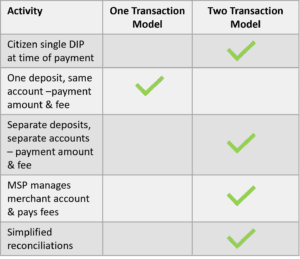If you missed the announcement – Visa and Mastercard will increase most of their credit card fees in April 2022. For years, Visa, Mastercard, Discover, and American Express (card brands) have reserved the right to review their Interchange fees every April and October. Of the more than 300 Interchange rates (fees), not every Interchange fee increases, and less typically decreases every April and October.
Let’s break here for a quick refresher on what Interchange fees are.
Interchange Fees
Interchange fees are the fees the card brands charge merchants for accepting debit/credit cards. Interchange fees costs reflect the risk of the card used:
- Debit cards have lower Interchange costs because they are tied to a bank account and pose less of a risk.
- Reward credit cards have a higher interchange rate because the card brands do not want to pay for your vacation you paid for with points.
- Corporate cardholders can potentially abuse corporate cards with the number of cards issued within an organization and therefore have the highest interchange rates.
- In-person transactions are less risky because card ownership can be verified, which results in lower interchange rates. After all, a fraudster is less likely to use a fraudulent card in person than online. If you are going to commit a crime, chances are you will not want to end up in jail over a fast-food meal, so the dollar amount factors into the interchange rate.
Ok, now back to the card brands announcement.
A few noteworthy things to unpack from Visa and Mastercard’s announcement for government agencies with payment service providers who assess their constituents a service or two-transaction convenience fees. But first, a little background.
Terminology
Mastercard and American Express use the term convenience fee to describe their two-transaction government payments model, whereas Visa uses the term service fee. Discover offers special Interchange rates for government payment processing but does not have an official name.
How it Works
Government payment processing service providers like IntelliPay pay your agencies’ payment processing costs from the service/convenience fees collected from your constituents. Therefore, allowing government agencies to receive 100% of the payment amount. Eligible government agencies (more on this below) should ensure that they are on the two-transaction service or convenience fee model instead of a one transaction convenience fee. The two-transaction model offers numerous reconciliations, accounting, and labor-saving benefits over the one transaction convenience fee model.

Merchant Accounts
There are two merchant accounts under the two-transaction service or convenience fee model. The payment service providers sets up one merchant account for the government agency’s payment. The payment service provider sets up the other merchant account for the payment service provider to assess a service or convenience fee to the constituent. For example, if a constituent sees two payments on their card statement, the government agency uses the two-transaction service/convenience fee model.
At the Time of Payment
When the payment is processed, the two transaction service or convenience fee is processed with 100% of the payment amount going to your government agency, and the service or convenience fee goes to the service processor to pay for the merchant processing fees.
For some processers the two-transaction fee process requires the cardholder to dip twice, once for the payment amount, and a second time for the fee. Obviously not an ideal situation for the cardholder or the agency that needs to explain why there are two dips.
Advanced payment processors like IntelliPay can process the transaction using Single DIP (EMV) Service Fee Processing.
Revenue Neutral
The two-transaction model is a revenue-neutral payment solution for government agencies; it costs nothing to participate (low volume accounts may incur a monthly fee or have higher two-transaction service/convenience fees). Payment service providers like IntelliPay pay the processing fees, maintain the merchant accounts on behalf of your agency and are on the hook for any credit card fee increases by the card brands.
Experience Counts
Suppose your government agency has selected a government payment processing service provider knowledgeable about the two-transaction service or convenience fee model. Your office and constituents should not worry about a service or two-transaction convenience fee increases. Since your service provider has set your two-transaction service/convenience fee high enough to withstand future Interchange increases.
That said, the two-transaction payment processing model has nuances which require service provider knowledge and experience and which government merchants need to be aware. We examine four of the nuances below.
Nuance 1
Even though there are one transaction and two-transaction convenience fees models, not every government agency qualifies for the two-transaction model.
For example, Visa limits participation in its two-transaction service fee model to the following merchant classification codes or MCCs:
8211 – Elementary and Secondary Schools
8220 – Colleges, Junior Colleges, Universities, and Professional Schools
8244 – Business and Secretarial Schools
8249 – Vocational Schools and Trade Schools
9211 – Court Costs, including Alimony and Child Support
9222 – Fines
9311 – Tax Payments
9399 – Government Services (Not Elsewhere Classified)
Government agencies that do not qualify for the two-transaction model, such as utilities (electric, gas, water, and sanitary), are only eligible for the one transaction convenience fee model. In addition, the one transaction convenience fee must be a fixed amount and only offered online.
Nuance 2
The two-transaction service or convenience fee can be fixed or variable and can be assessed for online and in-person transactions. Interestingly enough, in-person (card present) unregulated debit cards have higher Interchange fees than a card not present debit card transaction.
In other words, it’s better to treat debit and credit cards the same when it comes to setting the two-transaction service/convenience fee since the government agencies’ card mix can vary wildly from month to month.
Nuance 3
Corporate cards do not qualify for government interchange rates. For example, if a contractor uses a corporate card to pay building permits on multiple properties, the interchange costs on those transactions will be higher. More advanced processors will process payments with more data from the cardholder. The more data per transaction, the lower the risk and the interchange fee. Known as Level 2/3 processing, that, when available, can reduce the interchange fees on corporate card transactions that your government payment processor has to pay. Level 2/3 processing increases the likelihood the service or convenience fee can be the same for a constituent paying their property taxes.
To understand how this plays out, let’s look at the bigger picture. Your department processes both property tax payments and payments for building permits . Property tax payments and building permits each have higher payment amounts but only property taxes qualify for the lower government interchange rates and building permit fees do not.
Example
Let’s say your contractor uses their corporate card to pay for a permit online and the building departments payment service provider charges them a service/convenience fee of 2.50%. Depending on the type of corporate card the contractor uses, it will have an Interchange fee higher than 2.50%.
Your payment service provider needs to have processing experience with everything listed above, plus the technological sophistication to ensure a superior user experience for constituents while maintaining card brand compliance and providing back-end integration with existing systems.
Summary
To summarize, in the two-transaction model, the payment service provider uses the fee it assesses a constituent to pay for the payment processing of the payment merchant account and fee merchant account.
A one transaction convenience fee deposits both the payment and fee into the government agency’s bank account and results in the government agency paying the payment processing fees. The one transaction fee convenience model is a cost reduction strategy. No government agency will ever collect the exact convenience fee revenue to pay the merchant account fees.
Everything we have reviewed in this article contributes to a government agency’s card mix, which determines an appropriate one transaction convenience fee or two-transaction service or convenience fee.
If you would like a more detailed explanation of government payment processing, please download IntelliPay’s Government Electronic Payments Decision Making Guide found here.
About IntelliPay
IntelliPay, formerly GovTeller, is a SaaS provider of secure payment processing services to hundreds of government agencies nationwide. We are your trusted payment services provider with over 18 years of experience in government payments and over 100 years of cumulative experience in the payments industry.
Our State, County, and City in the cloud™ solutions are available as stand-alone and customized, integrated solutions to help modernize government services and online payments.
We have a solution for every payment challenge. Contact us for a free, no-obligation consultation.


